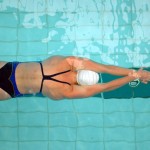 Swimming in open water is very alien for most people. Beginners, experienced triathletes and the elite all sometimes get nervous from open water swimming.
Swimming in open water is very alien for most people. Beginners, experienced triathletes and the elite all sometimes get nervous from open water swimming.
For the majority of most people it is almost impossible to sink when wearing a correctly fitted triathlon wet suit. Just try to dive down in 1.5m swimming pool wearing a wet suit, then try and touch the bottom. Being relaxed in a wetsuit will give you the biggest improvements in performance. It is perfectly normal to become nervous, your mind is telling you to not swim in open water to avoid going into the unknown.
Two important principles for open-water swimming success:
Practice swimming in open water. Firstly do not venture out too far. Stay close to the edge where you can easily get out of the water. Try and float on your back in a swimming pool and see how much effort it takes, then repeat with a wetsuit on and you will soon realize how easily you float without any effort. You will have considerably more confidence in open water once you have experienced the art of floating.
Never swim alone and always swim close to others. Make sure you have already discussed an emergency action plan and you know the address of the entrance for emergency services to arrive THE BEST safety decisions are always made before you get into the water.
Here are three how-to tips to gain comfort swimming in open water:
Swim in all different conditions; calm day’s windy days, dull days and bright sunny days. Learn to love and experience what Mother Nature decides to throw at you. Frequency of open water swimming builds up self confidence.
Before you venture into open water, practice in a pool breathing on both sides. Learn the water polo style of looking ahead. If possible, swim is an adjacent lane to an aqua-cise or fun swim session and the pool will have more waves than normal. This will better prepare you for open water swimming.
Sighting or correct navigation is easy to learn. Find out how often you need to look up before going off course. You may need to look up every 4, 6 or 8 strokes. The more you swim in open water the less often you will need to look up and still swim in as straight line. If you swim 2 metres in the wrong direction you will at least need to cover another 2m to get back on track. Use 2 points as reference, a buoy and a tall building or tree directly behind the buoy. Make sure when looking up to sight, you kick a little more to keep your body vertical in the water and avoid the legs sinking.
Mistakes to avoid:
-Only start swimming in open water only when YOU are ready, not when others are ready. It is much better to wait a few extra weeks for the water to warm up then try and swim in freezing cold water and lose any confidence you have. Taking the plunge too early can set you back months.
-Avoid swimming close to rocks, weedy areas, boat traffic and harbour walls where there is no place to exit the water.
-A wet suit can make you over confident, and will not prevent you from drowning.
Mark Kleanthous is an open water swim coach and has his own lake for individual coaching. He has competed in more than 450 triathlons and has competed as an elite and recorded some of the fastest T1 & T2 transition times overall. Mark Kleanthous has competed in triathlons for 30 consecutive seasons and crossed the finish line in more than 450 triathlons including 35 ironman events. He is the author of The Complete Book of Triathlon Training and is a full time sports and nutrition coach. Mark can be contacted via his web site www.ironmate.co.uk.
 Subscribe
Subscribe